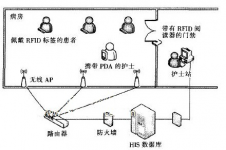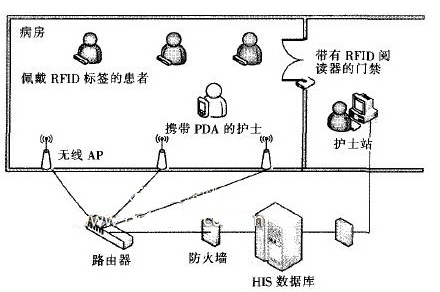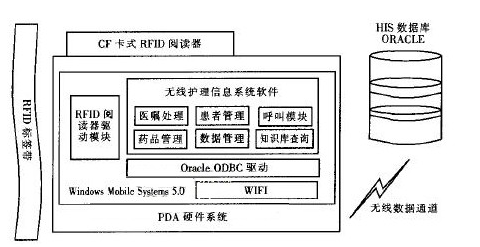
RFID-based wireless medical care
[ad_1]
1 Introduction
Due to the limitations of technology and objective conditions, hospitals have adopted various measures for a long time and have not been able to effectively reduce the occurrence of medical errors. In addition to having a bad influence on the reputation of medical institutions, medical errors have also caused irreparable losses to patients, as well as huge economic losses.
A patient needs to go through three steps from seeing a doctor to receiving treatment: the doctor examines the patient and issues a doctor’s order after getting a preliminary diagnosis, the nurse transfers the doctor’s order to the infusion or treatment card and prepares to execute it, and the nurse implements the treatment plan.
Each step of these three links is crucial. There can be no negligence, otherwise it will lead to medical errors. The medical order information errors can be reflected in the hospital information system, and most of the errors can be discovered and corrected before the nurse executes the medical order.
However, the current medical order is an open-loop process from issuing to executing. The medical order issued by a doctor is documented in the information system, but there is no objective and real-time record of who executes the medical order and when it is executed. The verification method is also too simple. The traditional “three checks and seven pairs” method is not ideal to implement, and there are hidden dangers of medical errors. Medical errors such as taking the wrong medicine, giving the wrong injection, and even getting the wrong knife sometimes occur.
With the development of wireless network technology and radio frequency identification technology (RFID), combining the two can effectively prevent and avoid the occurrence of medical errors.
With the support of wireless network technology and with RFID technology on this basis, real-time inspection and confirmation of each step in the execution of medical orders can be realized, and the unique identification of patient identity, medicines, blood bags, etc. can be achieved, which guarantees patients Safe, effective improvement of medical quality and reduction of medical errors will play a huge role
This article implements a wireless nursing information system based on RFID design. By deploying a wireless network in the ward, patients wear RFID tags, and RFID tags are attached to medicines and blood bags. Nurses can directly collect and enter patient information through a PDA handheld computer, such as :Who will execute the doctor’s order, when the doctor’s order will be executed, the patient’s physiological indicators, nursing status (medication, temperature measurement times, diaper change times, feeding times), etc., connected to the IP — PH0NE has a call function, which can effectively ensure that hospital staff can respond at any time The patient is quickly and accurately identified.
The patient tag tape can also be prevented from being replaced or removed at will, ensuring the uniqueness and correctness of the tag object. The system can effectively realize the closed-loop control of the whole process information of the medical order execution, prevent and avoid the occurrence of medical errors, thereby ensuring the safety of patients.
2 Introduction to RFlD technology
RFID (Radio Frequencv Identification) refers to radio frequency identification, which uses spatial electromagnetic induction or electromagnetic propagation to communicate, and realizes energy transfer and data transmission according to the timing relationship in the communication link, thereby realizing non-contact target identification and tracking.
The basic working method of the RFID system is to install the RFID tag on the identified object (stick, insert, wear, implant, etc.) when the identified object enters the reading range of the RFID reader. A wireless communication link is established between the tag and the reader.
The tag sends its own information, such as tag number and tag storage data, to the reader. The reader receives and decodes the information, and then transmits it to the background computer for processing to complete the entire information processing process.
RFID does not require a wired reader, and the RFID tag has another function, which allows the information on the tag tape to be updated.
The RFID reader can scan multiple label tapes at the same time, and each bar code must be read by the corresponding bar code scanner one by one; the linear bar code can only hold 10-20 characters of data.
In contrast, RFID readers are not limited by storage capacity and can store several thousand characters of data: In addition, RFID tag tapes can be wiped with alcohol, which effectively avoids use in humid environments or blood contamination and abrasion. In other situations, the barcode cannot be read and loses its effect, which is more suitable for applications in the medical industry.
3 Overall design of wireless nursing information system based on RFID
3.1 Schematic diagram of working environment
The working environment of the hospital’s digital RFID-based wireless nursing information system is shown in Figure 1. Wireless local area network is deployed in the ward, and wireless AP (Access Point) is deployed according to the working range of the PDA. The patient wears an RFID tag belt, and the nurse carries a PDA with RFID reading function to exchange information with HlS through the wireless network.
The nurse determines the patient’s identity according to the patient’s label, and at the same time realizes the confirmation of medicines when executing the medical order, and enters the medical order into the HIS through the PDA, who will execute the medical order, when the medical order will be executed, and the patient’s physical sign data. At the same time, an access control system is installed in the ward so that patients entering and leaving the ward can be automatically reflected on the nurse’s station, which is convenient for management.

Fig. 1 Design of working environment of wireless nursing information system based on RFlD
3.2 The overall structure of the system
The operating environment of the system is Windows Mobile Svstem 5.0. A CF card RFID reader is installed on the PDA. The data on the label is transmitted to the nursing information system through the driver to realize the unique confirmation of patients and medicines. The nursing information system is connected to the HlS database through the Oracle0DBC driver to realize data interaction, and the link layer is realized through a wireless network.
The nursing information system software is composed of patient management, drug management, medical order processing, data management, knowledge base query and call modules. The overall structure of the RFID-based wireless nursing information system is shown in Figure 2.

Figure 2 The overall structure of the RFlD-based wireless nursing information system
3.3 Functional design
The wireless nursing information system has the following functions
(1) The RFID tag can be scanned to uniquely determine the identity of the patient and the information corresponding to the medicine.
(2) Able to complete the patient’s humanities, discharge, transfer, transfer, bed replacement and corresponding cancellation operations, and be able to inquire about the patient’s flow.
(3) Enter and query laboratory test reports, enter patient physical information (such as blood pressure, body temperature, pulse, etc.), enter nursing information and diagnosis information on the first page of the medical record, etc.
(4) It can complete operations such as entry, proofreading, and invalidation of medical orders, enter medical order valuation items, realize query and processing in accordance with patients’ medical orders, and realize entry of medicines.
(5) Realize patient call module and WiFi-based IP-PHONE function to facilitate information exchange between nursing staff.
(6) Realize the knowledge base query, provide accurate, fast, convenient, and flexible best channels for nursing staff to acquire nursing knowledge and technology, which can meet the knowledge needs of nursing staff, so as to better serve patients’ health.
(7) Data management provides data backup and synchronization functions to ensure data security.
4 Implementation of RFID-based wireless nursing information system
4.1 Hardware system implementation
The hardware system of the RFID-based wireless nursing system mainly includes the following 4 parts:
(1) CF card type RF1D tag reader, the model is designated as Compact Flash Reader KD8, supports IS014443A (B), IS0 15693 standards;
(2) Pocket computer PDA, model HP iPAQ hx249Oc, running environment Windows M0bile 5.0:
(3) Wireless access point AP, model Gigabyte GN-A1 G, protocol is IEEE 8O2.118O2.11b:
(4) RFID label printer, the model is Intellitag PM4i, the working frequency is 1356 MHz, and it supports the IS0 15693 standard.
4.2 Software system realization
The software implementation of the RFID-based wireless nursing system includes database and application software implementation. The database directly uses the relevant tables in the “Military Medical No. 1” HIS database, including the patient’s main index, doctor’s order form, and price list. The tables to be added are the comparison table between the RFID tag and the patient ID number in the HIS database, and the comparison table between the drug RF1D tag and the doctor’s order, etc.
The application software adopts Microsoft.Net Framework 3.5 SDK. The development language is C#. The development environment is Micmsoff visual Studio 2008. The Sman De-vice CAB Proiect template is adopted. The software process is shown in Figure 3.

Figure 3 Software flow chart
In the process, first login and function selection. Then, according to the selected module, complete the monitoring of the whole process of the execution of the doctor’s order, or choose the IP-PHONE function based on WIFi. If you want to realize information query, enter the nursing knowledge expert system. After all operations are finally completed, log out of the system.
5 concluding remarks
This article implements a wireless nursing information system based on RFID, realizes the correct identification of patient identity and medicine, realizes the closed-loop execution of medical orders, and effectively prevents and avoids the occurrence of medical errors. The next step of research should focus on the wireless network security in the hospital, as well as the information security of RFID itself and the protection of patient privacy data.
[ad_2]



